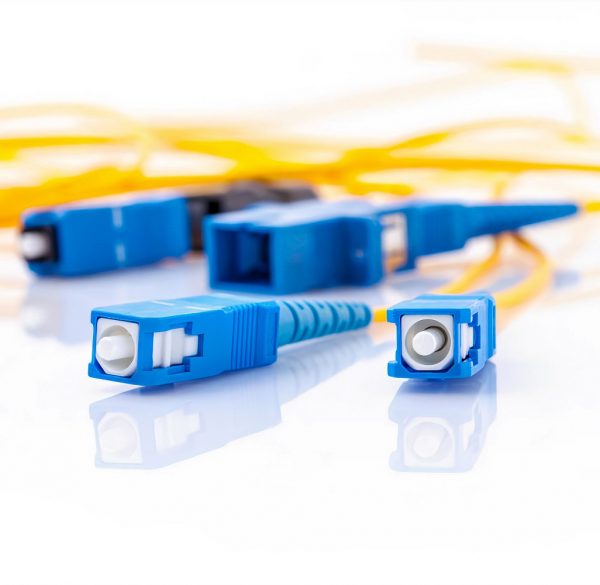ITU Developing New G.fin Standard for Home Fibre Networks

The International Telecommunication Union (ITU) is developing a new standard called G.fin, which could essentially create a novel fibre optic network inside your home in order to improve the speeds and connectivity directly to residential broadband routers and wireless (WiFi) access points etc.
At present most Local Area Networks (LAN) in the home environment tend to use a mix of WiFi and copper or coax based Ethernet cables, which over short distances (up to 100 metres for the best performance) have no problem carrying multi-Gigabit data speeds (e.g. CAT8 Ethernet LAN cables can handle up to 40Gbps).
Admittedly if you really wanted to make your own optical fibre network at home then that’s already possible, although it tends to require additional adapters / converters because the vast majority of consumer broadband routers simply don’t provide native support for such connectivity (they still use copper LAN cables).
Advertisement
Suffice to say that there isn’t a particularly pressing need to suddenly adopt a pure end-to-end fibre approach through the home, but that hasn’t stopped the ITU from moving into the development phase of G.fin. The new standard covers the creation of high-speed fibre-based in-premises transceivers (system architecture, physical layer and data link layer specification).
ITU Statement
The performance of the access network can no longer be judged only by the connection to the home (residential gateway). It must be judged by the quality and capacity of the link extending all the way to the end-user device.
Industry has achieved significant gains in the performance of the access segment up to the residential gateway with technologies like fibre access over XGS-PON, cable access over DOCSIS and copper access over G.fast. But with many devices now competing for connectivity, in-home distribution often struggles to match the performance achieved by the access segment.
The ITU G.fin project aims to overcome this imbalance with the delivery of a cost-efficient fibre technology for connectivity in the home. Success for G.fin will be industry’s ability to achieve optimal performance right up to the end-user device.
The project will describe the use cases, architecture, data link layer and physical layer of the envisioned fibre network connecting the residential gateway to the wireless access points in the home. This home fibre network will support high throughput, low latency and connection stability for wireless connectivity in the home.
We don’t entirely agree with the statement that “in-home distribution often struggles to match the performance achieved by the access segment,” not least because we’re talking more about wired (NOT wireless) links here and most broadband lines in the UK remain far slower (i.e. we’ve yet to see many people complain that their wired LAN is too slow, with performance issues usually stemming from the WiFi and broadband side).
A bigger problem is arguably the fact that far too many consumer broadband routers still only ship with 1Gbps LAN ports, which is despite the fact that faster standards exist. Admittedly if you increase the link speed then you also need to put in a more powerful CPU, which raises the cost, but modern devices (computers etc.) can already move data (internally) faster than 1Gbps and multi-gigabit home FTTP broadband is just around the corner (it’s already the norm in some countries).
Nevertheless, we’d would love to see full optical connectivity making its way into consumer broadband routers and other LAN connect-able devices, which might eventually also open up the possibility of merging the Optical Network Unit (ONT) on Fibre-to-the-Premises (FTTP) broadband lines into the same device (this would probably require more work to ensure interoperability between rival ISP networks).
Advertisement
One other benefit might come from the fact that optical fibre tends to be a lot cheaper than copper-based LAN cables and they’re also thinner, which makes them easier to hide. In any case the ITU look set to develop the standard for all this over the next couple of years (2022) and we’ll be interested to see what the end result looks like, even if it may initially struggle to catch-on.
Separately, the ITU has also recently amended the G.hn family of standards enable “home networks” to achieve speeds up to 10Gbps over coaxial cable and 5Gbps over “phoneline” cables (we assume they mean twisted-pair copper, but it’s not clear). In order to do this G.hn needed to develop a new physical layer and support spectrum bandwidth of 1GHz+. The new system also allows for coexistence with current coax technologies, such as DOCSIS (e.g. Virgin Media’s HFC broadband), by moving the operating spectrum to higher frequencies.
Mark is a professional technology writer, IT consultant and computer engineer from Dorset (England), he also founded ISPreview in 1999 and enjoys analysing the latest telecoms and broadband developments. Find me on X (Twitter), Mastodon, Facebook, BlueSky, Threads.net and Linkedin.
« New UK Smart Data Laws May Help Broadband Deal Comparisons
Ofcom – Full Fibre Broadband Grows to Cover 14% of the UK »






















































Who uses coax in their home network? 10base2 is very dead!
I do think more devices should just come with an SFP+ cage, I have a UDM Pro and I have an SFP+ 10G WAN and LAN, but that won’t help me as VM will give me a SH4.0 with gigabit LAN when I get 1G.
Really seems like a shame as including an SFP+ cage adds little to the BoM allowing customers that wish to add a module to do so.
Some houses come with coax points pre-built into several rooms. You can use those with a simple adapter to extend LAN, without having to run new cables.
They could really use an SFP+ module in the SH4
https://www.actiontec.com/wifihelp/wifibooster/how-does-moca-work/
Thanks for the reminder by the way. Must check the UDM Pro software and see if it’s no longer total garbage missing fundamental routing functionality as the ‘controller’ side seems a far higher priority.
A lot of houses in the US use MOCA over their coax wiring. Some cable ISPs even promote it as a first class installation option; they run the coax from the street into the home and into every room, and that coax will then carry all TV & IP traffic.
I’ve never seen such a setup in the UK, but have in some European countries.
Given that Cat6a cabling is good for 10Gbps over 100m, there are very few homes that need anything more. Further the homes for which Cat6a is insufficient will be in the price bracket where some traditional fibre will do the trick. Simplex SFP’s and SFP+’s are cheap and the preterminated fibre itself is as cheap as chips. The simplex LC connector is sufficiently small that you can easily feed them through a small hole so running the fibre preterminated is feasible, and easier than ever with modern tight bend radius fibre.
Seems like a job creation program to me for people with nothing to do.
There’s no harm providing some competition to 802.3 ethernet. Up to 5gbps in the home, ethernet indeed has mainstream solutions. Given the time line of developing the new optical standard and getting adoption, and then products to market, who knows if we’ll find ourselves routinely needing multigigabit local connections?
As more and more storage becomes Solid-state, that may be the catalyst for faster in-home networks. For example, if the average computing device in 2030 is sporting storage capable of sustaining 1GB/s (nvme ssds can do 4x this today, so average PCs could expect this baseline), and cloud computing is more prevalent, users might expect their networks to not be 1000x slower.
I don’t see enough of a justification in here for this standard to even exist – fibre LAN equipment is very much commodity, so how is G.fin going to reach the scale where it can compete on price? It’s not exactly going to be competing on performance with 100GE.
Why so negative regarding new or revised standards?. The ITU sets up Study Groups all the time to look at the current standards, new emerging functionality and compatibilities. This particular study group was looking at Networks, Technologies and Infrastructures for Transport, Access and Home, a wide range of ITU standards. With manufacturer feedback they identified a requirement which they have determined to be specifically looked at.
We will probably not see anything until 2022. There have been a number of proprietary solutions for Fibre use within the home (mainly in US and Far East) but the various improvements in WIFI, Powerline etc have all competed. We could await the current commercial Fibre based offerings to come down in price but what the domestic market will need is something more plug and play including easier cabling connectivity and cheaper media conversion. If this new standard results in more effective home network technologies that are not proprietary surely that has to be good.
We can’t even seem to get large developers to install cheap as chips ducting into newbuilds, so as forward looking as fibre home LAN is, it’s still going to be near on impossible to retrofit.
Piece of cake in my 1890s lath and plaster gaff, theres tons of space between all the walls, just has to be mouse proof and unaffected by the sub zero ‘in wall cooling’ draughts 🙂